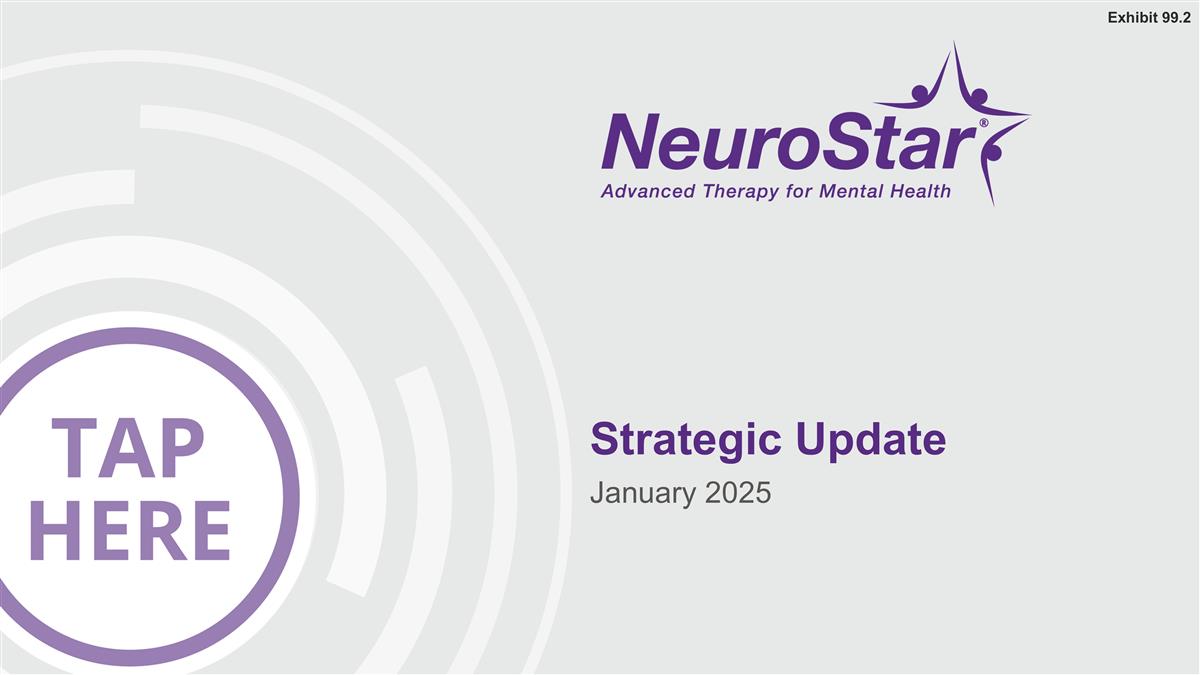
Strategic Update January 2025 Exhibit 99.2
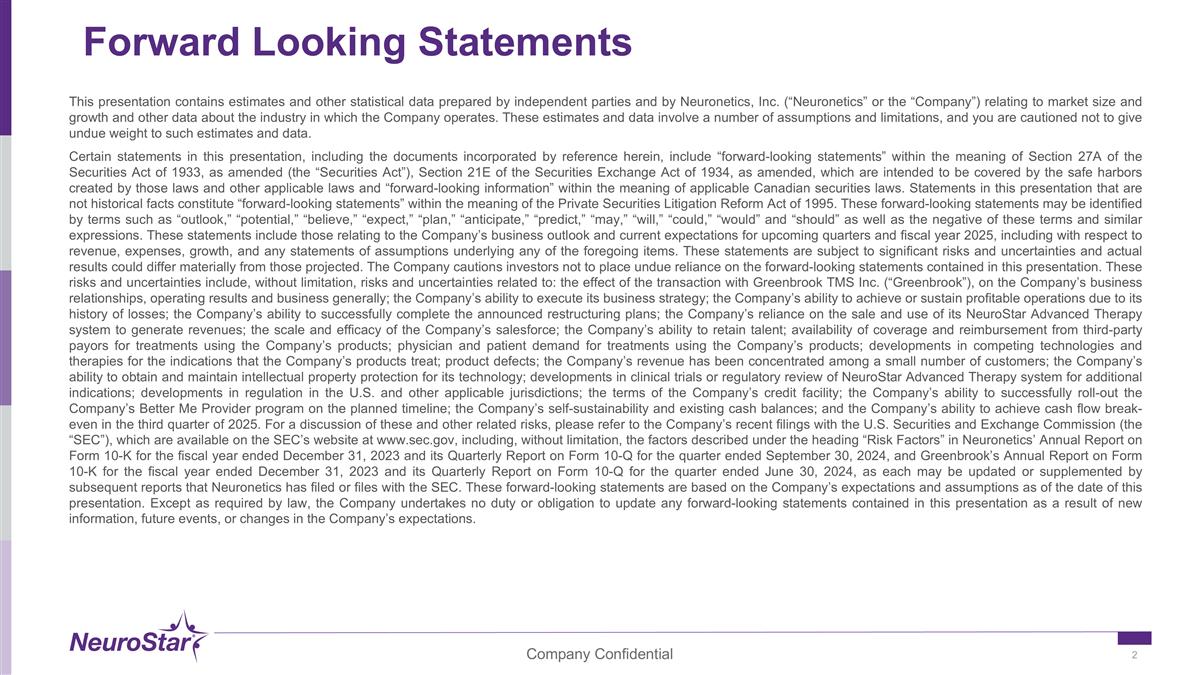
Forward Looking Statements This presentation contains estimates and other statistical data prepared by independent parties and by Neuronetics, Inc. (“Neuronetics” or the “Company”) relating to market size and growth and other data about the industry in which the Company operates. These estimates and data involve a number of assumptions and limitations, and you are cautioned not to give undue weight to such estimates and data. Certain statements in this presentation, including the documents incorporated by reference herein, include “forward-looking statements” within the meaning of Section 27A of the Securities Act of 1933, as amended (the “Securities Act”), Section 21E of the Securities Exchange Act of 1934, as amended, which are intended to be covered by the safe harbors created by those laws and other applicable laws and “forward-looking information” within the meaning of applicable Canadian securities laws. Statements in this presentation that are not historical facts constitute “forward-looking statements” within the meaning of the Private Securities Litigation Reform Act of 1995. These forward-looking statements may be identified by terms such as “outlook,” “potential,” “believe,” “expect,” “plan,” “anticipate,” “predict,” “may,” “will,” “could,” “would” and “should” as well as the negative of these terms and similar expressions. These statements include those relating to the Company’s business outlook and current expectations for upcoming quarters and fiscal year 2025, including with respect to revenue, expenses, growth, and any statements of assumptions underlying any of the foregoing items. These statements are subject to significant risks and uncertainties and actual results could differ materially from those projected. The Company cautions investors not to place undue reliance on the forward-looking statements contained in this presentation. These risks and uncertainties include, without limitation, risks and uncertainties related to: the effect of the transaction with Greenbrook TMS Inc. (“Greenbrook”), on the Company’s business relationships, operating results and business generally; the Company’s ability to execute its business strategy; the Company’s ability to achieve or sustain profitable operations due to its history of losses; the Company’s ability to successfully complete the announced restructuring plans; the Company’s reliance on the sale and use of its NeuroStar Advanced Therapy system to generate revenues; the scale and efficacy of the Company’s salesforce; the Company’s ability to retain talent; availability of coverage and reimbursement from third-party payors for treatments using the Company’s products; physician and patient demand for treatments using the Company’s products; developments in competing technologies and therapies for the indications that the Company’s products treat; product defects; the Company’s revenue has been concentrated among a small number of customers; the Company’s ability to obtain and maintain intellectual property protection for its technology; developments in clinical trials or regulatory review of NeuroStar Advanced Therapy system for additional indications; developments in regulation in the U.S. and other applicable jurisdictions; the terms of the Company’s credit facility; the Company’s ability to successfully roll-out the Company’s Better Me Provider program on the planned timeline; the Company’s self-sustainability and existing cash balances; and the Company’s ability to achieve cash flow break-even in the third quarter of 2025. For a discussion of these and other related risks, please refer to the Company’s recent filings with the U.S. Securities and Exchange Commission (the “SEC”), which are available on the SEC’s website at www.sec.gov, including, without limitation, the factors described under the heading “Risk Factors” in Neuronetics’ Annual Report on Form 10-K for the fiscal year ended December 31, 2023 and its Quarterly Report on Form 10-Q for the quarter ended September 30, 2024, and Greenbrook’s Annual Report on Form 10-K for the fiscal year ended December 31, 2023 and its Quarterly Report on Form 10-Q for the quarter ended June 30, 2024, as each may be updated or supplemented by subsequent reports that Neuronetics has filed or files with the SEC. These forward-looking statements are based on the Company’s expectations and assumptions as of the date of this presentation. Except as required by law, the Company undertakes no duty or obligation to update any forward-looking statements contained in this presentation as a result of new information, future events, or changes in the Company’s expectations.
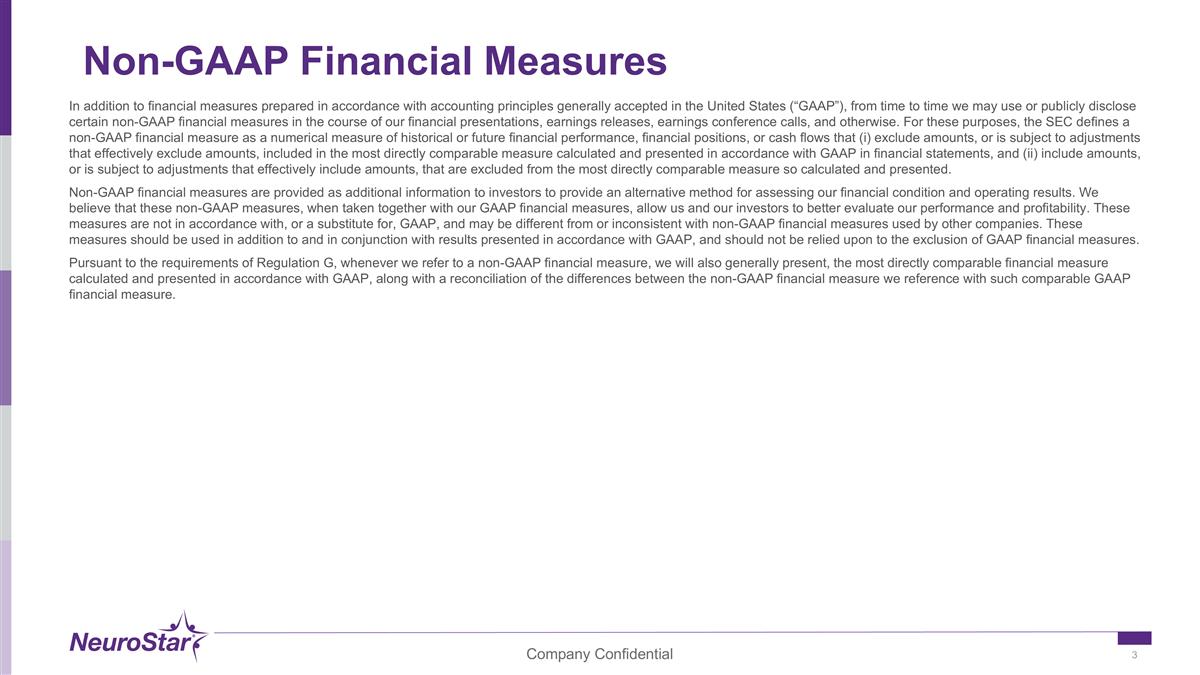
Non-GAAP Financial Measures In addition to financial measures prepared in accordance with accounting principles generally accepted in the United States (“GAAP”), from time to time we may use or publicly disclose certain non-GAAP financial measures in the course of our financial presentations, earnings releases, earnings conference calls, and otherwise. For these purposes, the SEC defines a non-GAAP financial measure as a numerical measure of historical or future financial performance, financial positions, or cash flows that (i) exclude amounts, or is subject to adjustments that effectively exclude amounts, included in the most directly comparable measure calculated and presented in accordance with GAAP in financial statements, and (ii) include amounts, or is subject to adjustments that effectively include amounts, that are excluded from the most directly comparable measure so calculated and presented. Non-GAAP financial measures are provided as additional information to investors to provide an alternative method for assessing our financial condition and operating results. We believe that these non-GAAP measures, when taken together with our GAAP financial measures, allow us and our investors to better evaluate our performance and profitability. These measures are not in accordance with, or a substitute for, GAAP, and may be different from or inconsistent with non-GAAP financial measures used by other companies. These measures should be used in addition to and in conjunction with results presented in accordance with GAAP, and should not be relied upon to the exclusion of GAAP financial measures. Pursuant to the requirements of Regulation G, whenever we refer to a non-GAAP financial measure, we will also generally present, the most directly comparable financial measure calculated and presented in accordance with GAAP, along with a reconciliation of the differences between the non-GAAP financial measure we reference with such comparable GAAP financial measure.
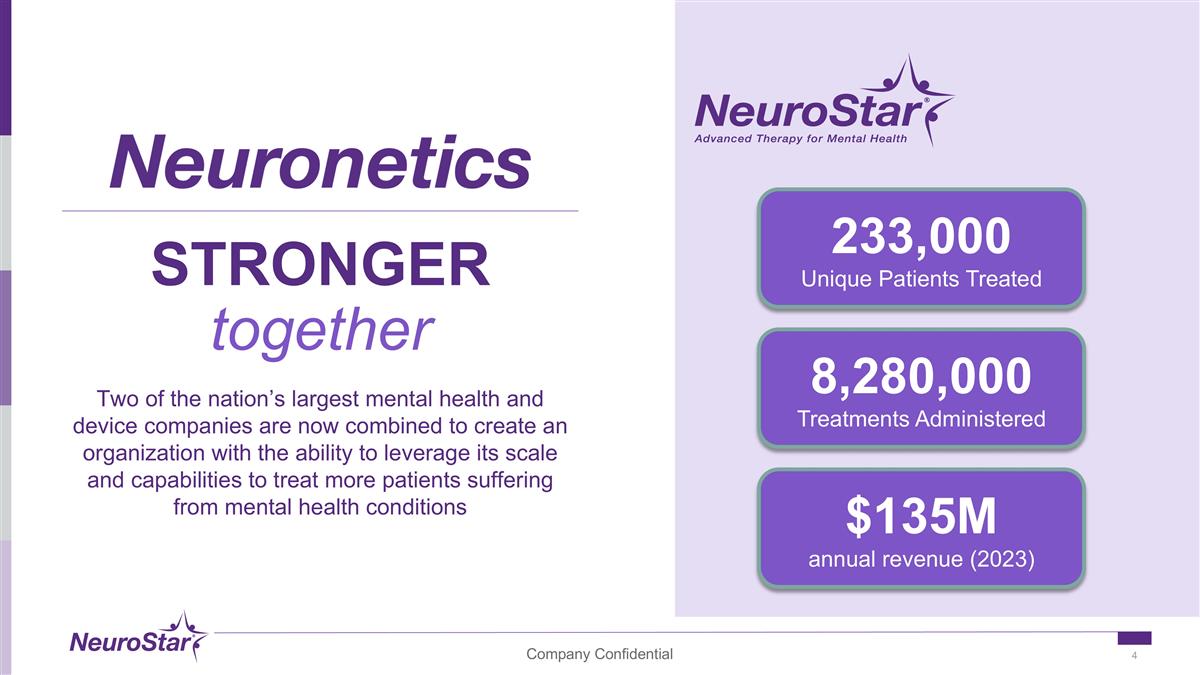
STRONGER together 233,000 Unique Patients Treated 8,280,000 Treatments Administered $135M annual revenue (2023) Two of the nation’s largest mental health and device companies are now combined to create an organization with the ability to leverage its scale and capabilities to treat more patients suffering from mental health conditions
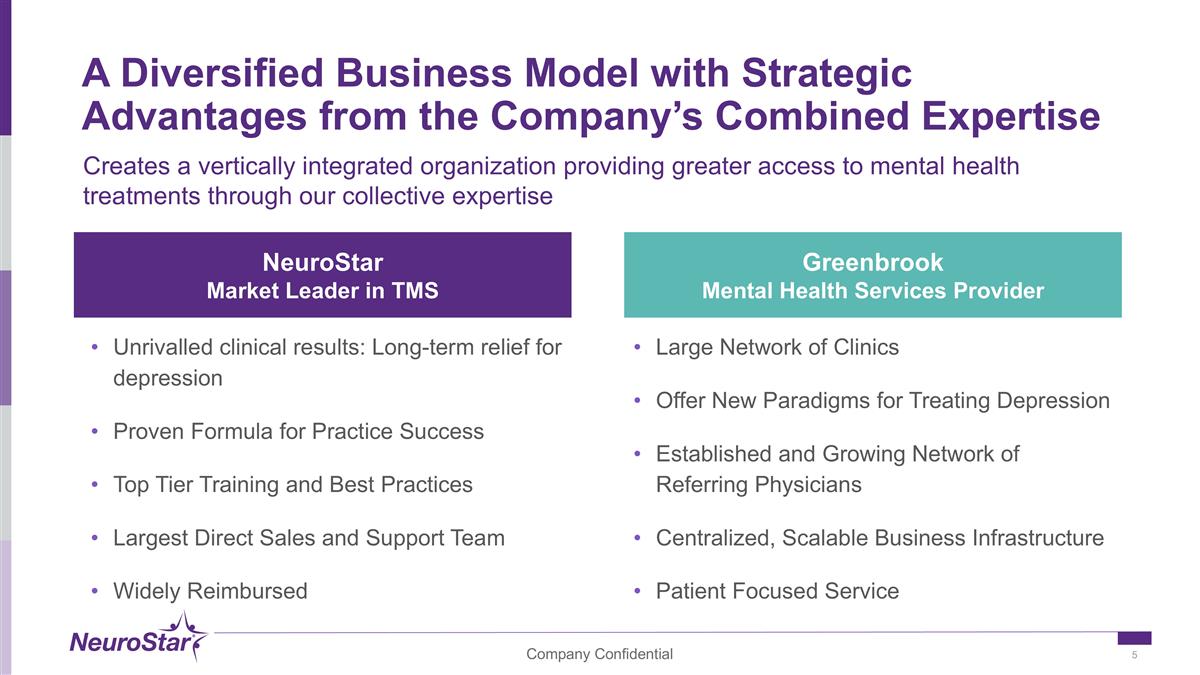
A Diversified Business Model with Strategic Advantages from the Company’s Combined Expertise Creates a vertically integrated organization providing greater access to mental health treatments through our collective expertise NeuroStar Market Leader in TMS Greenbrook Mental Health Services Provider Large Network of Clinics Offer New Paradigms for Treating Depression Established and Growing Network of Referring Physicians Centralized, Scalable Business Infrastructure Patient Focused Service Unrivalled clinical results: Long-term relief for depression Proven Formula for Practice Success Top Tier Training and Best Practices Largest Direct Sales and Support Team Widely Reimbursed
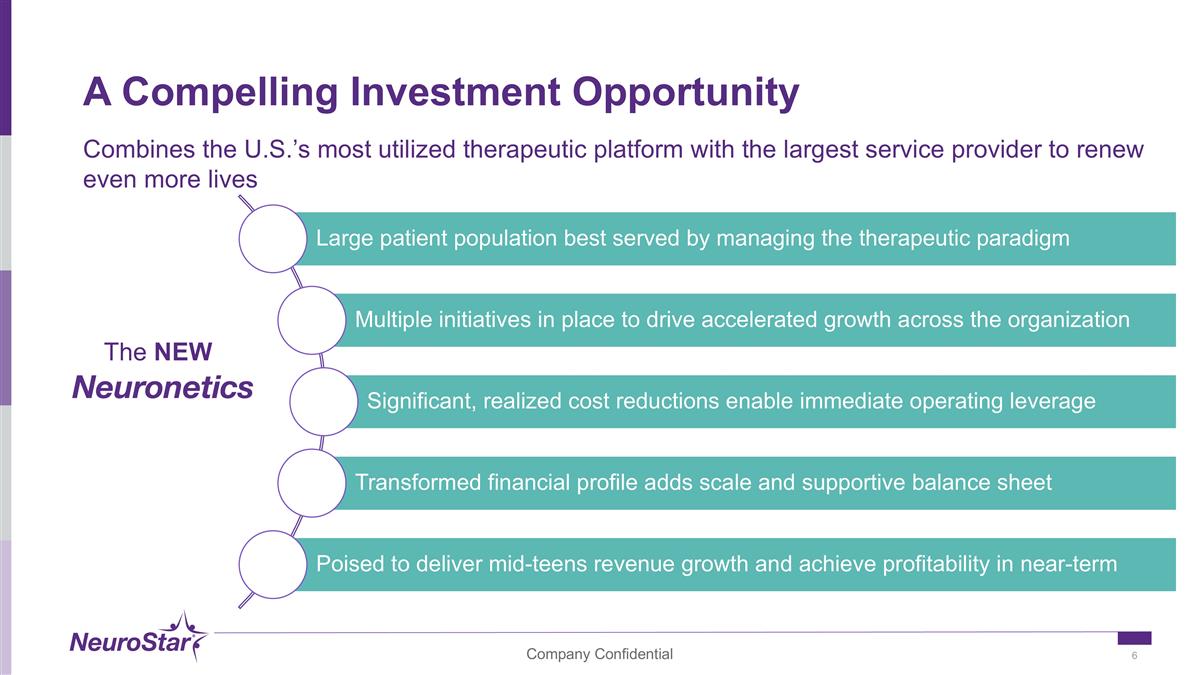
A Compelling Investment Opportunity Combines the U.S.’s most utilized therapeutic platform with the largest service provider to renew even more lives The NEW
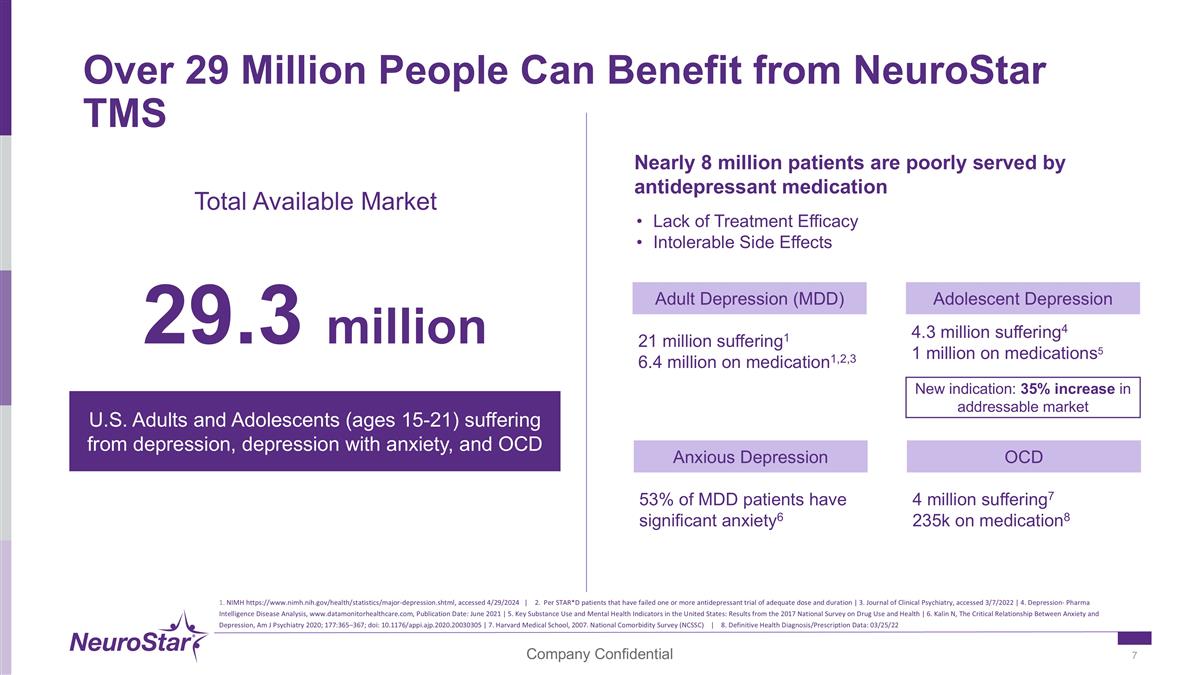
Over 29 Million People Can Benefit from NeuroStar TMS U.S. Adults and Adolescents (ages 15-21) suffering from depression, depression with anxiety, and OCD Total Available Market 29.3 million Nearly 8 million patients are poorly served by antidepressant medication Lack of Treatment Efficacy Intolerable Side Effects Adult Depression (MDD) 21 million suffering1 6.4 million on medication1,2,3 Anxious Depression 53% of MDD patients have significant anxiety6 Adolescent Depression 4.3 million suffering4 1 million on medications5 OCD 4 million suffering7 235k on medication8 New indication: 35% increase in addressable market 1. NIMH https://www.nimh.nih.gov/health/statistics/major-depression.shtml, accessed 4/29/2024 | 2. Per STAR*D patients that have failed one or more antidepressant trial of adequate dose and duration | 3. Journal of Clinical Psychiatry, accessed 3/7/2022 | 4. Depression- Pharma Intelligence Disease Analysis, www.datamonitorhealthcare.com, Publication Date: June 2021 | 5. Key Substance Use and Mental Health Indicators in the United States: Results from the 2017 National Survey on Drug Use and Health | 6. Kalin N, The Critical Relationship Between Anxiety and Depression, Am J Psychiatry 2020; 177:365–367; doi: 10.1176/appi.ajp.2020.20030305 | 7. Harvard Medical School, 2007. National Comorbidity Survey (NCSSC) | 8. Definitive Health Diagnosis/Prescription Data: 03/25/22
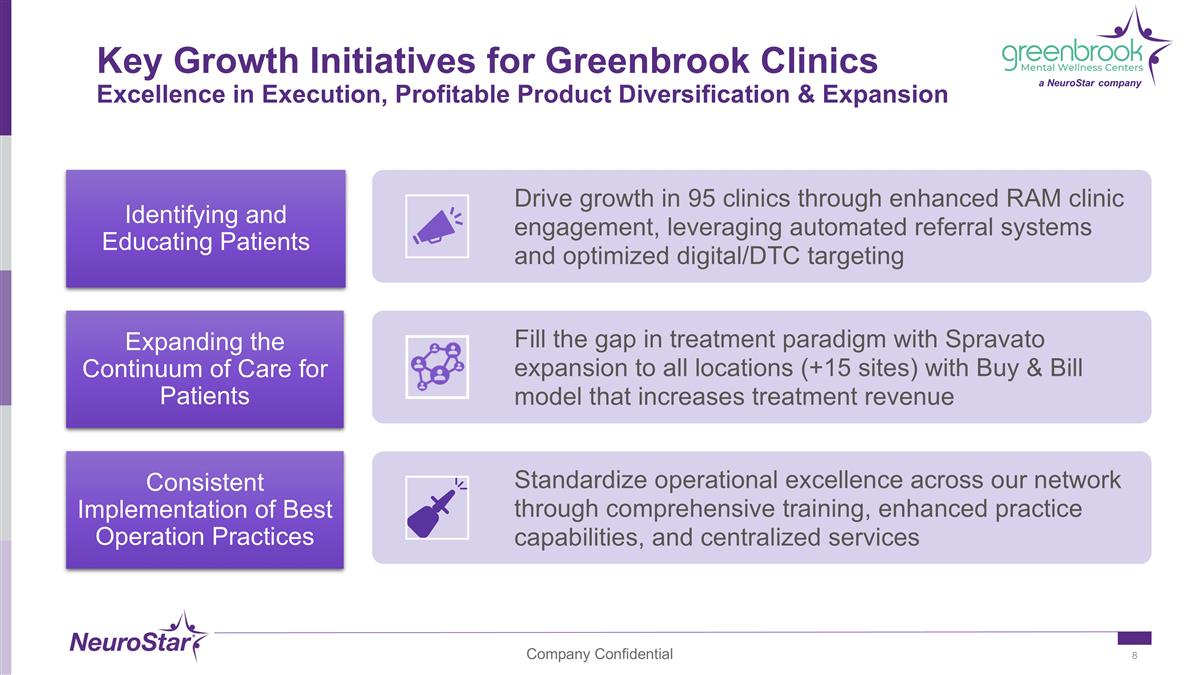
Key Growth Initiatives for Greenbrook Clinics Excellence in Execution, Profitable Product Diversification & Expansion Expanding the Continuum of Care for Patients Identifying and Educating Patients Consistent Implementation of Best Operation Practices
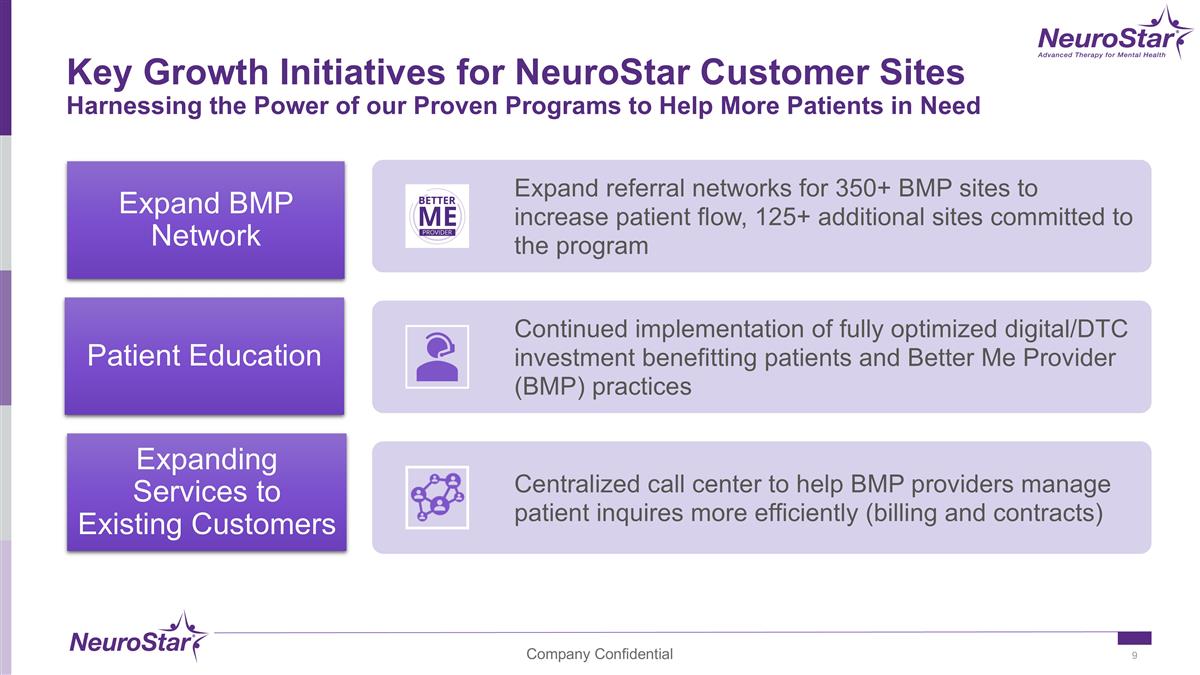
Key Growth Initiatives for NeuroStar Customer Sites Harnessing the Power of our Proven Programs to Help More Patients in Need Expand BMP Network Patient Education Expanding Services to Existing Customers
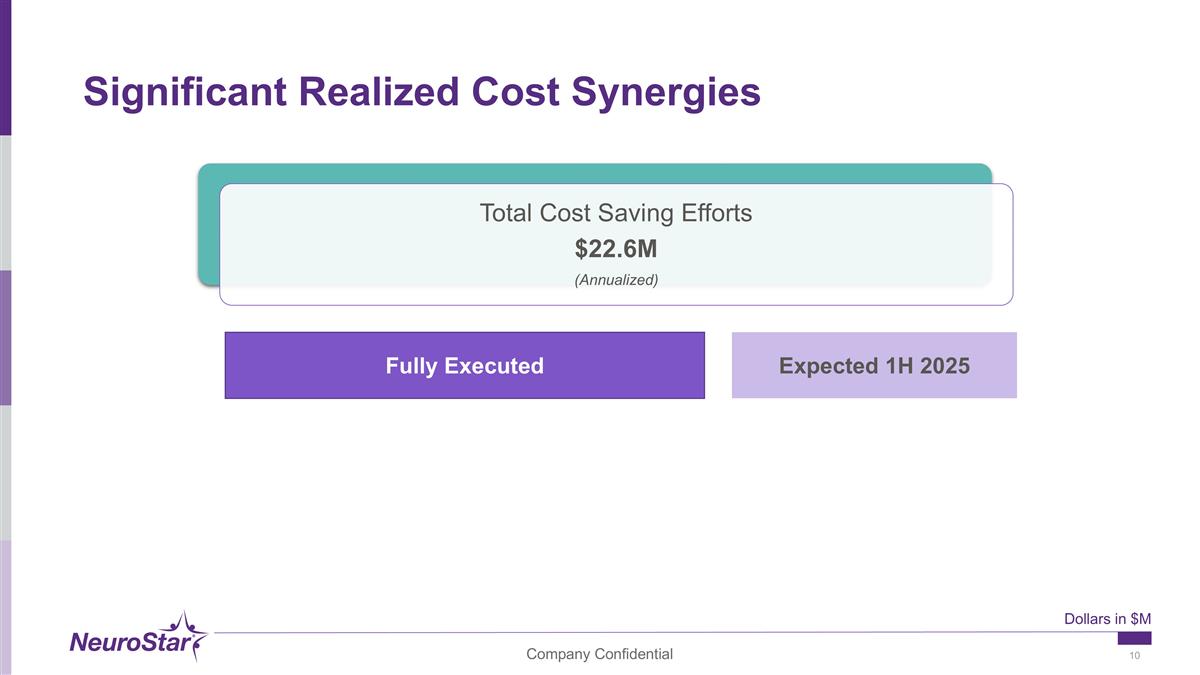
Dollars in $M Significant Realized Cost Synergies Fully Executed Expected 1H 2025
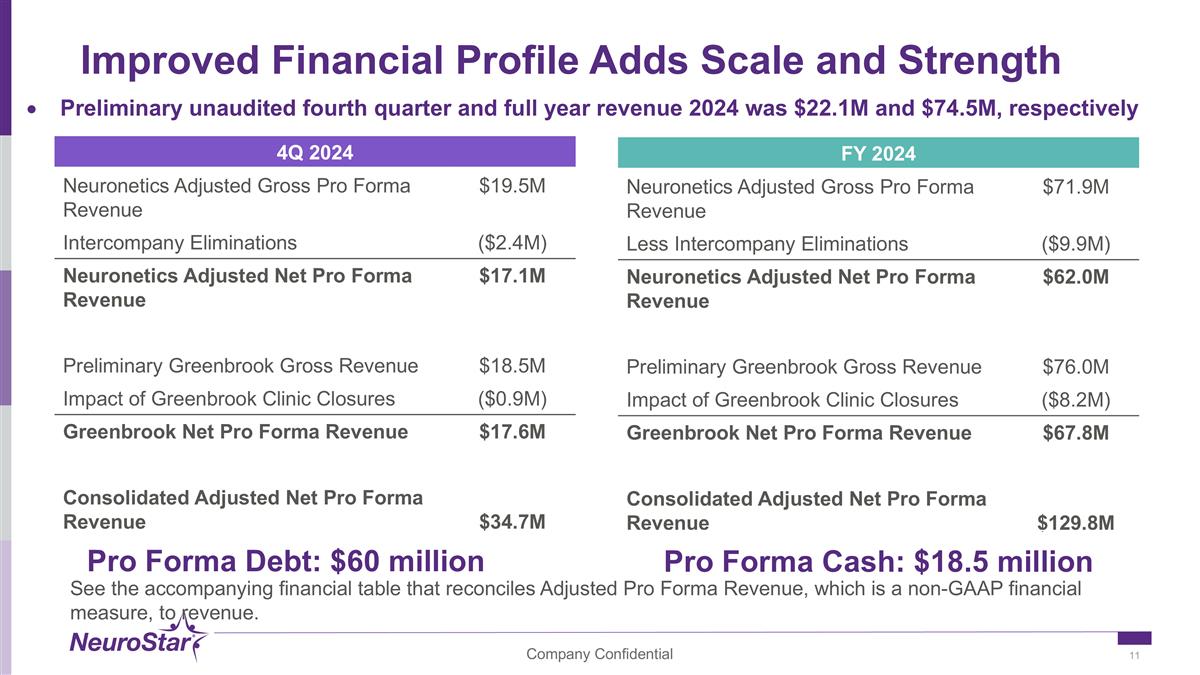
Improved Financial Profile Adds Scale and Strength 4Q 2024 Neuronetics Adjusted Gross Pro Forma Revenue $19.5M Intercompany Eliminations ($2.4M) Neuronetics Adjusted Net Pro Forma Revenue $17.1M Preliminary Greenbrook Gross Revenue $18.5M Impact of Greenbrook Clinic Closures ($0.9M) Greenbrook Net Pro Forma Revenue $17.6M Consolidated Adjusted Net Pro Forma Revenue $34.7M FY 2024 Neuronetics Adjusted Gross Pro Forma Revenue $71.9M Less Intercompany Eliminations ($9.9M) Neuronetics Adjusted Net Pro Forma Revenue $62.0M Preliminary Greenbrook Gross Revenue $76.0M Impact of Greenbrook Clinic Closures ($8.2M) Greenbrook Net Pro Forma Revenue $67.8M Consolidated Adjusted Net Pro Forma Revenue $129.8M Pro Forma Debt: $60 million Pro Forma Cash: $18.5 million Preliminary unaudited fourth quarter and full year revenue 2024 was $22.1M and $74.5M, respectively See the accompanying financial table that reconciles Adjusted Pro Forma Revenue, which is a non-GAAP financial measure, to revenue.
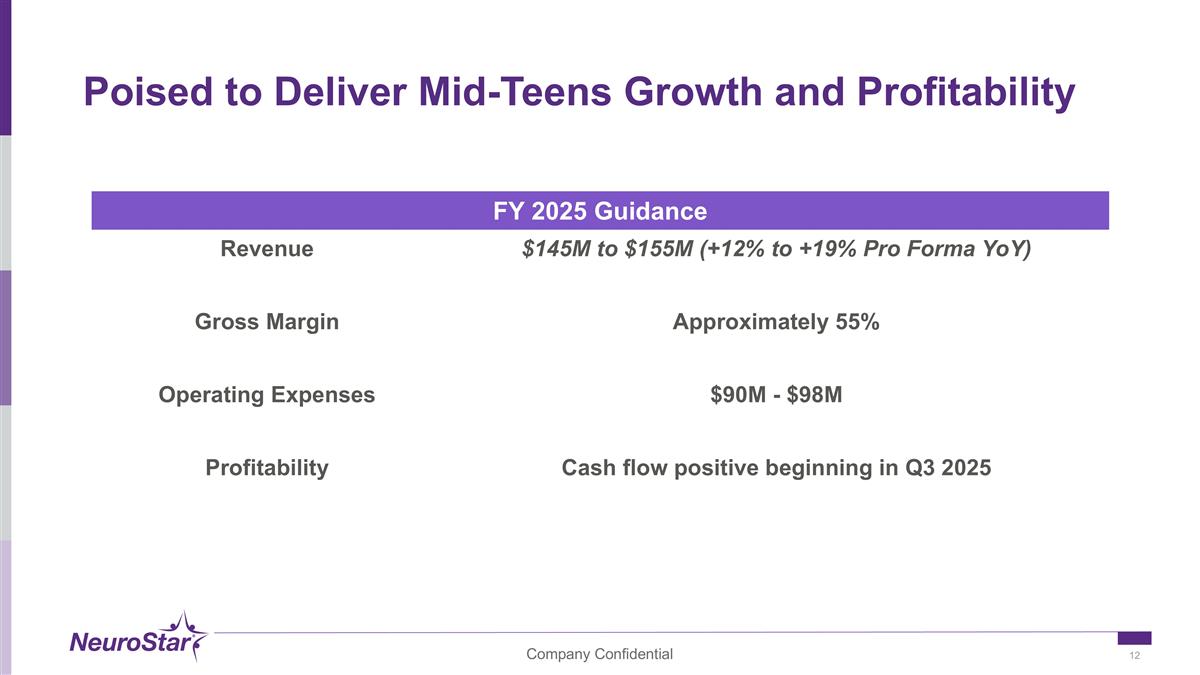
Poised to Deliver Mid-Teens Growth and Profitability FY 2025 Guidance Revenue $145M to $155M (+12% to +19% Pro Forma YoY) Gross Margin Approximately 55% Operating Expenses $90M - $98M Profitability Cash flow positive beginning in Q3 2025
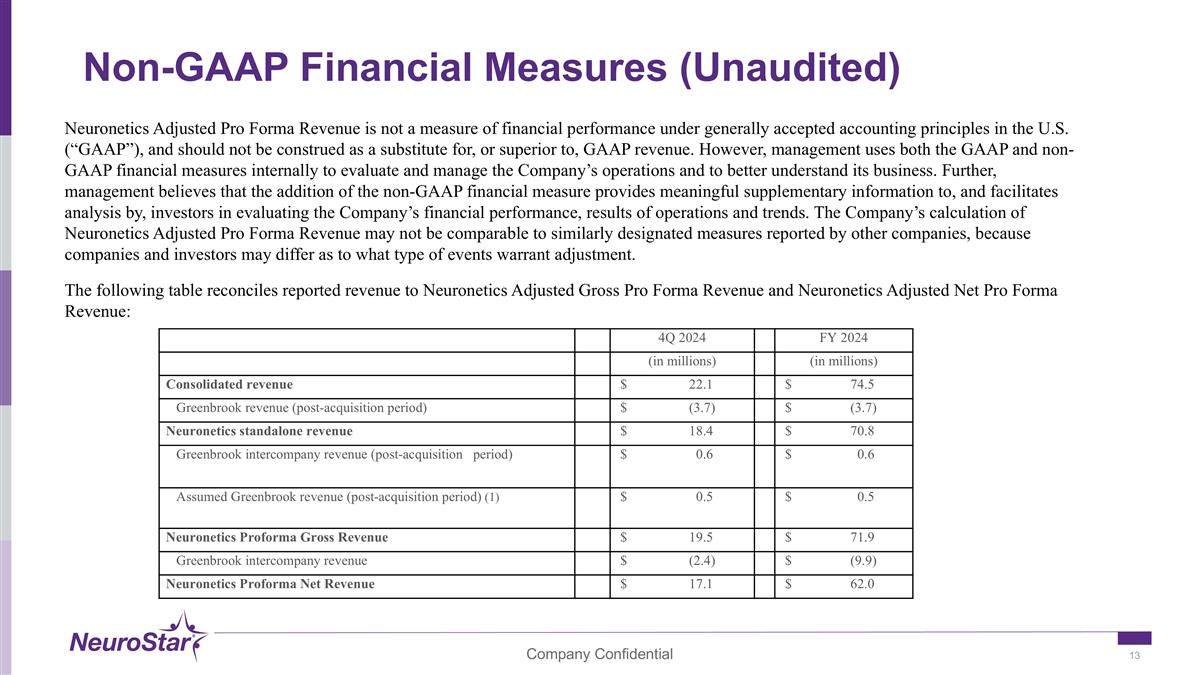
Non-GAAP Financial Measures (Unaudited) 4Q 2024 FY 2024 (in millions) (in millions) Consolidated revenue $ 22.1 $ 74.5 Greenbrook revenue (post-acquisition period) $ (3.7) $ (3.7) Neuronetics standalone revenue $ 18.4 $ 70.8 Greenbrook intercompany revenue (post-acquisition period) $ 0.6 $ 0.6 Assumed Greenbrook revenue (post-acquisition period) (1) $ 0.5 $ 0.5 Neuronetics Proforma Gross Revenue $ 19.5 $ 71.9 Greenbrook intercompany revenue $ (2.4) $ (9.9) Neuronetics Proforma Net Revenue $ 17.1 $ 62.0 Neuronetics Adjusted Pro Forma Revenue is not a measure of financial performance under generally accepted accounting principles in the U.S. (“GAAP”), and should not be construed as a substitute for, or superior to, GAAP revenue. However, management uses both the GAAP and non-GAAP financial measures internally to evaluate and manage the Company’s operations and to better understand its business. Further, management believes that the addition of the non-GAAP financial measure provides meaningful supplementary information to, and facilitates analysis by, investors in evaluating the Company’s financial performance, results of operations and trends. The Company’s calculation of Neuronetics Adjusted Pro Forma Revenue may not be comparable to similarly designated measures reported by other companies, because companies and investors may differ as to what type of events warrant adjustment. The following table reconciles reported revenue to Neuronetics Adjusted Gross Pro Forma Revenue and Neuronetics Adjusted Net Pro Forma Revenue:












